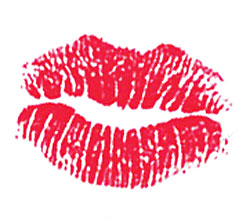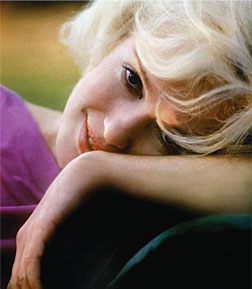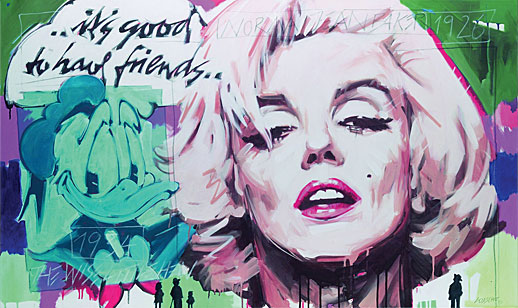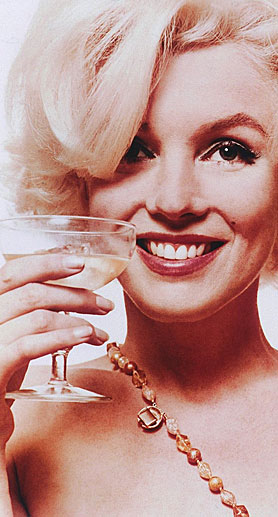|
Douglas Kirkland, One Night with Marilyn (3), 1961/2003 © Douglas Kirkland
|
 |
A Nut on the Plane: Marilyn in Midflight
As The Andy Warhol Museum prepares to welcome Marilyn Monroe: Life as a Legend to Pittsburgh, CARNEGIE magazine asked film historian Barry Paris for his take on the legendary Pop icon. A longtime Pittsburgh Post-Gazette film critic, Paris is co-author of Tony Curtis: The Autobiography, published in 1993. His best-known works include acclaimed biographies of film stars Louise Brooks, Greta Garbo, and Audrey Hepburn.
By Barry Paris
In Some Like It Hot, the 1959 Billy Wilder classic considered America’s best film comedy of all time, wealthy imposter Tony Curtis asks ditzy chanteuse Marilyn Monroe, “Do you play the market?”
 “No,” she replies sweetly, “the ukulele.” “No,” she replies sweetly, “the ukulele.”
He falls hopelessly in love with her. So do we, the audience. What else can you do?
No one has stoked America’s collective imagination more than Marilyn, that most fragile icon and immortal element of our popular culture. Her breathtaking beauty, sexuality, and charismatic innocence captivated and defined the era of her lifetime. Half a century later, her post-mortem mystique continues to radiate and evolve—as evidenced by Marilyn Monroe: Life as a Legend, a traveling exhibition opening October 23 at The Andy Warhol Museum.
This multi-dimensional celebration sheds new light on the dynamic public and private transformation of Norma Jeane Baker into Marilyn Monroe, through a full range of media—from the high-fashion photography of Bert Stern and Richard Avedon to Andy Warhol’s Pop Art silkscreens, and beyond. Monroe devotees searching for insight into her screen-siren persona and the identity crisis beneath it will find fresh nutrients in 250 strikingly diverse photographs, prints, paintings, and videos.
Viewings of her films (see page 32 for dates and times) will accompany the exhibition, which is sponsored by PNC Financial Services Group. Among them, you’ll find the apotheosis of Monroe’s bright and dark sides—her euphoric screen presence battling off-screen demons and impending disaster—in Some Like It Hot.
When Wilder first proposed a comedy about two nebbish musicians joining an all-girl band to escape the Chicago mob, producer David O. Selznick replied, “You want machine guns and dead bodies and drag gags in the same picture? Forget it, Billy. You’ll never make it work.”
Indeed, the idea of Tony Curtis and Jack Lemmon cross-dressing, Marilyn Monroe crooning, and George Raft lampooning the St. Valentine’s Day massacre sounded like a perfect recipe for disaster. But Wilder’s inspired direction and script (co-written with I.A.L. Diamond) somehow made it work, and his three stars gave the performances of their lives.
Little-known: Wilder originally wanted Bob Hope and Danny Kaye (later Frank Sinatra) to play the two guys, and Mitzi Gaynor for Sugar Kane (née Kowalski), the sexy singer. Praise Jesus for their unavailability.

Well-known: The difficulty of working with Monroe, in general. The screen’s most alluring sex goddess was also its most dysfunctional actress. But all the good, bad, and ugly known quantities about working with Marilyn—or rather, about Marilyn working—would converge with unknown ones during the making of Some Like It Hot—perversely and ironically, the movie manifesting her worst work habits and best results.
“Like kissing Hitler”
In 1958, Monroe was in a state of depression after a miscarriage. She had, however, moved on from her failed marriage to baseball slugger Joe DiMaggio by upgrading to playwright Arthur Miller. If she and the “Yankee Clipper” were a mismatch made in celebrity heaven, she and Miller were an even more incongruous egghead-bubblehead duo.
By one account, Miller thought it would raise her spirits to make another Wilder comedy after the success of their Seven Year Itch three years before. By another, she took the Sugar part because Miller needed money to pay his legal bills stemming from the House Un-American Activities Committee witch hunt.
 In any case, Marilyn looked and acted nervous throughout the production, and was forever late for shooting. After each scene, she called out “coffee!” and was brought a thermos containing straight vermouth. She was also neurotically dependent on her coach-handler Paula Strasberg (who followed her around the set holding an umbrella over her head) and pathologically incapable of remembering the simplest of lines. In any case, Marilyn looked and acted nervous throughout the production, and was forever late for shooting. After each scene, she called out “coffee!” and was brought a thermos containing straight vermouth. She was also neurotically dependent on her coach-handler Paula Strasberg (who followed her around the set holding an umbrella over her head) and pathologically incapable of remembering the simplest of lines.
Willy Rizzo, Marilyn Monroe (2), 1962/2005.
© Photo by Willy Rizzo
Curtis, who did his drag role “straight,” actually played three characters: Joe, the musician—interested only in girls and money; Josephine, his female front—aloof and scared of men; and a bored millionaire, who happened to talk just like Cary Grant.
“The men’s stuff was easy,” recalls Curtis, now 85. “It was the ladies’ stuff that had me worried. Billy brought in a female impersonator to work with Jack and me and teach us how to walk and hold our hands …We had our legs and chests shaved, eyebrows plucked, hips padded. To find the appropriate bra was no easy matter. I'm a 36D myself.”
Orry-Kelly, the film's costume designer, told Curtis that one day when he was fitting Marilyn, he told her, “You know, Tony's ass is better-looking than yours.” And Marilyn responded, ‘Oh, yeah? Well he doesn't have tits like these!’—and then yanked open her blouse to prove it.
Some Like It Hot came in at a cost of $2.8 million, unusually expensive for a comedy in 1959. But it earned back $15 million and made history—as did Curtis’ most shocking remark at the time. Asked what it was like making screen love to Marilyn, he replied: “It was like kissing Hitler.”
It was The Putdown Heard ’Round the World, and it “went viral”—then as now. When I asked Billy Wilder about it in 1992, he said: “I never met anyone as utterly mean as Marilyn Monroe, nor as utterly fabulous on the screen. She paid absolutely no attention to anybody. She never thought, ‘We’re doing 80 takes, and these guys are standing here, cramping, they’re not going to get any better—in fact, it may kind of curdle on us.’ That’s what Tony meant when he said it was like kissing Hitler.”
People thought he was being incredibly cruel, but “it was just a throwaway line,” says Curtis about the whole experience. “I’d say, ‘Billy, how many [expletive] takes are we gonna do?’ And Billy would say, ‘When Marilyn gets it right, that’s the take I’m going to use.’ The odd thing was, it could take her 40 or 50 takes to get out one line, but sometimes she did a whole long scene—like the one in the train berth with Jack and all the girls piled inside—on the first take. You just never knew.”

Wolfgang Loesche, DD and MM, 2003 © Wolfgang Loesche
Marilyn’s own response to the Hitler remark later surfaced in a LIFE magazine interview taped just six weeks before she died in 1962. Asked about Curtis’ comment, her angry, hurt reaction is not wholly coherent and, in retrospect, very sad: “That’s his problem ... It’s not him, it’s somebody else ... Out with him—get somebody else!” Like everyone else, she interpreted it as a vicious erotic insult.
 The overall experience left the director a wreck. “We were in midflight,” said Wilder, “and there was a nut on the plane.” The overall experience left the director a wreck. “We were in midflight,” said Wilder, “and there was a nut on the plane.”
Such comments got him in trouble, sparking a famous telegram war in which Arthur Miller blamed Wilder for another miscarriage Marilyn suffered, just 12 hours after the final shoot. Their volleys included this one from Billy: “Had you, dear Arthur, been not her husband but her writer and director, and been subjected to all the indignities I was, you would have thrown her out on her can, thermos bottle and all, to avoid a nervous breakdown. I did the braver thing. I had a nervous breakdown.”
After Andy Warhol, Marilyn, published by Sunday B Morning,
1967/1978, © Andy Warhol Foundation
“We were in midflight, and there was a nut on the plane.”
-Billy WIlder, on working with Marilyn Monroe
Wilder later apologized, and Marilyn was encouraged to do the same. She phoned him after a recording session for the Some Like It Hot soundtrack album, but Wilder’s wife Audrey said he was out. “Well, when you see him, will you give him a message from me?” she asked. “Please tell him to go f— himself.” Pause. “And my warmest personal regards to you, Audrey.”
Fifteen minutes and then some
Fifteen minutes of fame are to die for. Fifteen years of it can literally kill you.
“I’m an artificial product,” Marilyn said famously in 1960. Fame as an artificial creation was much explored by Andy Warhol in his iconic Marilyn paintings, made shortly after her death in 1962. Based on Gene Korman's 1953 publicity shot of Marilyn for Niagara and later mass-produced in the now-ubiquitous 1967 silkscreen prints, Warhol presents a kind of lovely, lurid commodity, as did Sam Shaw’s famous subway-grate shot—a blast of air blowing her skirt up high—from Seven Year Itch. On the other hand, Ernst Haas’s pensive shots from The Misfits set reveal the discontented waif behind the commodity.
“Warhol and Monroe were both deeply complex personas,” says Eric Shiner, The Warhol’s Milton Fine Curator of Art. “Each was equated with fame and the world of high society, yet each harbored numerous insecurities and dark thoughts. It was natural for Warhol to choose Monroe as a subject, for she not only represented two of Andy’s favorite topics—glamour/fame and death/disaster—but in many ways, she also became an idealized portrait of everything he wanted to be, and an all-too-real representation of all that he was.”
For better or worse, the most photographed woman in the world seemed most at home in front of a camera. The role of photography in creating American culture’s ideal of female sexuality is at the heart of the exhibition: Tom Kelley’s infamous red velvet images that created a sensation as Playboy’s first centerfold in 1954; Douglas Kirkland’s sensuous bed sheet series titled One Night with Marilyn, in her bewitching state of undress; Bert Stern’s capture of her joie de vivre in the beloved Here’s to You! champagne glass image from her final sitting.
“Fame has nothing to do with the meaning of life—famous actor, famous doctor, famous politician, famous murderer,” Tony Curtis mused. “Fame in itself is a profession. If you’re Marlon or Elvis or Sinatra, that profession demands certain things. There’s an irony about saying, ‘I want top billing and $1 million for two weeks’ work. I want all that money and billing—but leave me alone.’ People like Garbo got undone when the paparazzi descended and the flashbulbs started popping. It drove Monty Clift crazy. They couldn’t handle it.”

Above left: Bert Stern, “Here’s to you” from The Last Sitting, 1962/1978
© Bert Stern
|
|
To accompany Life as a Legend, The Warhol will draw on its expansive archives to display dozens of photographs of Marilyn collected by Warhol, which speaks to the artist’s obsession with, and creation of, the red-carpet cult. He famously said, “More than anything, people just want stars.” On October 23 and 24, from 10 a.m.-10 p.m., The Warhol will celebrate its newest exhibition, as well as its 15th anniversary, with a free, 24-hour RADical opening featuring a Marilyn look-a-like contest, curator tours, art-making, and more.
The Warhol will also host five Friday night film programs during the run of the exhibition:
November 12, 7 p.m., $10 admission
Don't Bother to Knock (1952), directed by Roy Ward Baker, 76 min. Niagara (1953), directed by Henry Hathaway, 92 min.
November 19, 8 p.m., $7.50 admission
River of No Return (1954), directed by Otto Preminger, 91 min.
December 3, 7 p.m., $10 admission
Gentlemen Prefer Blondes (1953), directed by Howard Hawks, 91 min.
How to Marry a Millionaire (1953), directed by Jean Negulesco, 95 min.
December 10, 8 p.m., $7.50 admission
Some Like It Hot (1959), directed by Billy Wilder, 120 min.
December 17, 8 p.m., $7.50 admission
The Misfits (1961), directed by John Huston, 124 min.
|
|
The end of innocence
After Some Like It Hot, Marilyn would complete only one more film, The Misfits (1961), co-starring Clark Gable. Miller had written the story and screenplay—about a despairing divorcée—as a Valentine gift for her. But by the time filming started their marriage was beyond repair, and she was becoming more and more hostile toward him. Within 10 days of final shooting, it was announced that they were separating—and that Clark Gable had died of a heart attack. Gable’s widow said the “eternal waiting” and stress surrounding Marilyn on the set had contributed to it. Monroe herself acknowledged and regretted it. In the following months, her drug-and-alcohol dependence worsened. A Mexican divorce from Miller was granted January 24, 1961. By February, she was back in Payne Whitney Psychiatric Clinic.
Her final fitful movie-making attempt, Something’s Got to Give for Fox, found her absent for 21 of 33 shooting days. She was fired and died a week later, August 5, 1962, of an accidental or suicidal alcohol and barbiturate overdose.
If asked to name the male equivalent of her in the pop culture offhand, one might cite James Dean (for sex appeal/tragedy) or Elvis Presley (for lasting fame/impact). But neither of those men had Marilyn’s visceral hold on the imagination; Dean died too soon and unrealized; Presley, too late and overexposed.
Marilyn’s iconic male equivalent might have been a different kind of performer—the young, rakishly handsome President of the United States. The fact that they shared a powerful public and private sexual attraction—culminating in that astonishing May 19, 1962 “Happy birthday!” event at Madison Square Garden—makes the phenomenon of their conjunction even more remarkable.
|

 “No,” she replies sweetly, “the ukulele.”
“No,” she replies sweetly, “the ukulele.”
 In any case, Marilyn looked and acted nervous throughout the production, and was forever late for shooting. After each scene, she called out “coffee!” and was brought a thermos containing straight vermouth. She was also neurotically dependent on her coach-handler Paula Strasberg (who followed her around the set holding an umbrella over her head) and pathologically incapable of remembering the simplest of lines.
In any case, Marilyn looked and acted nervous throughout the production, and was forever late for shooting. After each scene, she called out “coffee!” and was brought a thermos containing straight vermouth. She was also neurotically dependent on her coach-handler Paula Strasberg (who followed her around the set holding an umbrella over her head) and pathologically incapable of remembering the simplest of lines.



 The overall experience left the director a wreck. “We were in midflight,” said Wilder, “and there was a nut on the plane.”
The overall experience left the director a wreck. “We were in midflight,” said Wilder, “and there was a nut on the plane.”